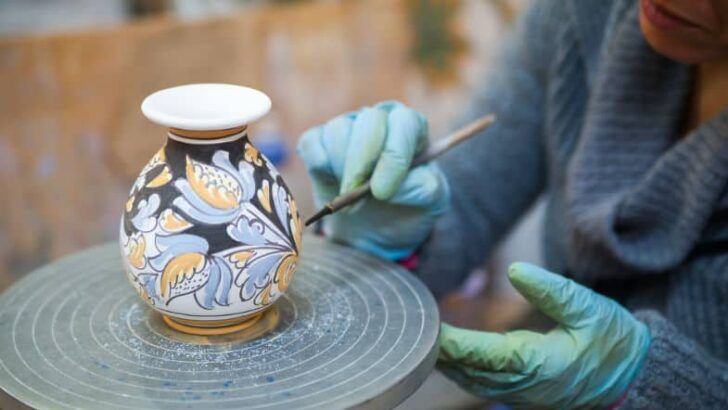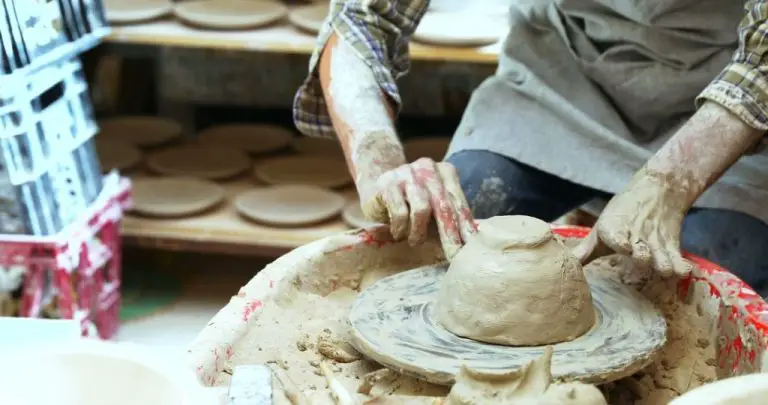Can You Use Amaco Velvet Underglaze On Bisque?
What is Amaco Velvet Underglaze?
Amaco Velvet is a specialty underglaze produced by Amaco, a leading manufacturer of ceramic supplies. Unlike standard underglazes which create a glossy finish, Amaco Velvet underglazes produce a velvety, matte look on cured clay bisqueware. According to the Amaco website, “Saturated color, dependability, and versatility make Velvets as popular for professionals as they are for children. Velvets fire true-to-color as a Cone 04 mid-range glaze.”
Velvet underglazes can be applied to bisqueware or greenware and are available in a wide range of vivid colors. The velvety appearance comes from the formulation of the underglaze which contains minerals that disrupt the glaze layer, preventing a glossy finish. Velvet underglazes are versatile and can be used alone or in combination with other glazes and underglazes.
Using Velvet on Bisqueware
Yes, Amaco velvet underglaze can be used directly on bisqueware. This smooth, velvety underglaze is specially formulated to be applied to bare bisque pottery. The velvety appearance comes from the product’s finely ground texture that allows it to adhere evenly to the porous bisque surface.
When applying velvet underglaze to bisque, it’s important to keep in mind that the underglaze will soak into the clay body differently than on a glazed surface. The bisque’s absorbent nature means the velvet underglaze will appear slightly lighter after firing. Using light pressure and thin coats will help achieve an even application.
To ensure proper adhesion, the bisque should be free of any dust or contaminants before applying the underglaze. Smooth the underglaze gently over the bisque surface using light, even strokes. Let the coats dry fully between applications for best results. With a bit of practice, you can create smooth velvet finishes directly on bare bisque pieces.
Firing Requirements
When using Amaco Velvet underglaze on bisqueware, it’s important to fire to the proper temperature range to achieve the desired results. According to Amaco, Velvet can be fired to cone 06-6[1]. However, the most common firing range is cone 06-04. Firing to at least cone 06 (1828°F/1000°C) will burn off any residual organics and fuse the underglaze to the clay body. The Velvet underglaze can also be fired up to cone 4 (2134°F/1166°C) for more durability.
It’s not recommended to fire Velvet underglaze above cone 5 (2167°F/1185°C) as it may start to melt and lose its characteristic matte finish. When firing on bisqueware, it’s ideal to fire to at least the bisque temperature. For example, if the bisque was fired to cone 04, the Velvet should be fired up to at least cone 04 as well to properly bond it to the bisque surface[2].
No matter what temperature is chosen, it’s important to fire at the rate recommended for the clay body and allow sufficient hold time at temperature to fully fuse the Velvet. This will help achieve the best results.
Achieving an Even Coat
To achieve a smooth, consistent finish with Velvet Underglaze on bisqueware, there are a few key techniques:

First, make sure the bisque is free of any dust or debris before applying the underglaze. Wipe it down with a clean, damp sponge. Let the bisque fully dry before painting.
When applying the underglaze, use soft brush strokes and avoid overworking any single area. It’s better to apply multiple thin layers rather than one thick coat. Let each layer fully dry before adding the next. Thicker applications are more likely to pool or drip.
Diluting the underglaze slightly with water, around 10%, can help it spread more smoothly. Test dilution on a bisque tile first.
Most recommend using a soft brush rather than a sponge for the best coverage. Foam and bristle brushes designed for underglazes work well. Rinse the brush frequently in water to keep it working properly.
Some bisque surfaces are more porous and may absorb more underglaze. In those cases, an extra coat focused on problem spots can help even out the overall appearance.
Firing too soon, before the underglaze fully dries, is a common cause of uneven results. Give the painted bisque adequate time to dry thoroughly before firing.
With the right preparation, brushing technique, and firing schedule, Velvet Underglaze can produce very smooth, professional looking finishes on bisqueware.[https://shop.amaco.com/glazes-underglazes/underglazes/v-velvet-underglaze/]
Common Problems
Amaco Velvet Underglaze can be susceptible to some common issues when used on bisqueware if not applied properly. Some of the problems to be aware of include:
Cracking – If applied too thickly or unevenly, the Velvet Underglaze may crack during firing. To avoid this, apply thin and even coats according to package directions. Source
Poor Adhesion – Bisque that is dusty, unclean, or too smooth may lead to poor adhesion of the Velvet Underglaze, causing it to flake or peel off. Proper bisque preparation and following firing guidelines can prevent this. Source
Color Changes – Some colors, especially whites, may shift tone or develop a yellowish tint after firing. This is normal, but can be minimized by applying thin coats. Test colors before use. Source
Troubleshooting Guidelines
If you notice cracking, peeling, or flaking when using Amaco Velvet Underglaze on bisqueware, there are a few troubleshooting steps you can take:
First, ensure the bisqueware is properly fired before applying Velvet Underglaze. Bisque firing should reach cone 04-06 for best results. Under-fired bisque can cause the underglaze to crack or peel. According to this post on a ceramic arts forum, firing too hot can also cause issues with Velvet adhering properly.
Next, check that your Velvet Underglaze is well-stirred and free of lumps before applying. Old or poorly mixed underglaze may not coat the bisqueware evenly. As recommended in this underglaze troubleshooting guide, test your underglaze on a bisque tile to ensure proper application.
Finally, make sure to apply Velvet Underglaze in thin, even coats. Too thick of an application can lead to cracking or peeling. Let each layer dry completely before adding another coat. 3-4 thin layers typically provides good coverage on bisque.
Following proper firing, mixing, and application techniques will help avoid most issues with using Velvet Underglaze on bisqueware. Check the manufacturer’s instructions as well for any other tips.
Velvet vs Standard Underglazes
There are some key differences between Amaco Velvet and standard underglazes that provide unique benefits when using Velvet:
Velvet has a velvety matte finish, whereas standard underglazes have a glossy finish. The velvety texture allows for blending and shading that is not possible with glossy underglazes (https://shop.amaco.com/glazes-underglazes/underglazes/v-velvet-underglaze/).
Velvet adheres well to raw bisqueware, while standard underglazes don’t work as well on porous bisque according to some users. Velvet sits on top of the bisque rather than absorbing in, allowing for richer colors (https://www.reddit.com/r/Pottery/comments/v47lid/lug_underglaze_vs_velvet_underglaze/).
The velvety finish also hides light texture on the bisque surface. Subtle bisque imperfections disappear under velvet, but might still show through standard underglazes.
Velvet has excellent suspension qualities that prevent settling on the shelf compared to some standard underglazes. It has a smooth creamy consistency that applies beautifully.
Overall, Velvet’s unique matte finish and application properties make it a popular choice for adding color while retaining the tactile bisque texture.
Recommended Bisqueware
Amaco Velvet Underglaze can be used on a variety of bisqueware surfaces. However, some bisque types and surfaces provide optimal results.
Bisqueware with a smoother surface allows the Velvet Underglaze to spread more evenly and reduces pooling or streaking issues. Products like Amaco’s Smooth Textured Clay or Smooth White Low Fire Clay are ideal (source). Staying away from extremely porous clays like terracotta bisque can help achieve better control over the underglaze application.
In terms of bisque temperature, mid-range 04-6 cone bisque provides a nice balance between absorption and hardness for Velvet Underglaze. Firing in this cone range helps set the clay body while still allowing the color to permeate slightly (source). Bisque fired too high like cone 10 can prevent adequate absorption.
It’s also recommended to have bisque pieces thoroughly cleaned and free of any dust before applying Velvet Underglaze. This helps the underglaze properly adhere to the bisque surface.
Creative Uses
The Velvet Underglaze line offers a variety of unique creative techniques not possible with standard underglazes. The velvety texture allows colors to be blended, layered, and mixed in new ways.
One popular technique is to layer multiple colors of Velvet Underglaze on top of each other to create depth and dimension. The velvet texture grabs onto the layers underneath, helping the colors blend softly into one another. For example, you can brush on a coat of turquoise Velvet Underglaze, let it dry, then brush purple over the top. The colors will blend together in a vibrant, multi-dimensional look not achievable with regular underglazes.
You can also use a wet sponge or brush to selectively remove layers of Velvet Underglaze, revealing the colors underneath. This is referred to as the “resist” technique. For example, layer red over black Velvet Underglaze, then use a wet sponge to remove the red from raised areas of your piece. This will expose the black underglaze in a hand-drawn look. There are limitless possibilities for combining colors and creating patterns this way. As Amaco says, “Let the Velvet Underglazes inspire you!” (Source)
Overall, the versatile Velvet Underglaze line offers all kinds of new creative techniques for potters looking to take their work to the next level.
Summary
Amaco Velvet underglaze can be used successfully on bisqueware if proper techniques are followed. Apply thin, even coats allowing to dry completely between layers. Firing to Cone 06 with adequate hold time will fuse the colors. Troubleshoot issues like pinholes or blistering by thinning the velvet, applying fewer coats, and ensuring proper bisque firing. Overall, velvet underglazes allow vivid, saturated colors on bisque that stand out beautifully after firing.

